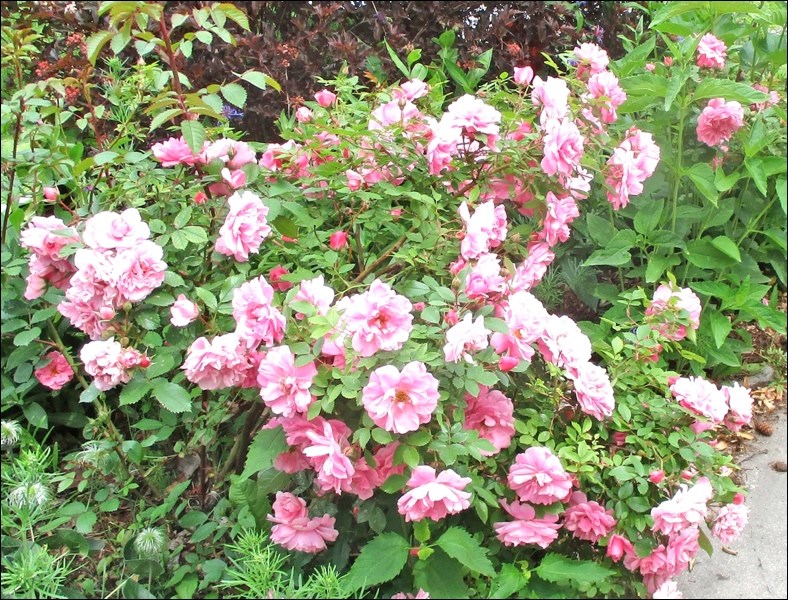If someone tells you growing roses in Saskatchewan is like growing any other shrub, either they have never grown roses, or they lucked out with their soil, microclimate and the particular cultivar they were growing.
While many shrubs are adaptable to various soils, roses are more selective. In much of Saskatchewan we are blessed with either sandy or heavy clay soils, neither of which are conducive to growing roses. Those with soils between these two extremes are lucky and can probably get away with adding organic matter and then be ready to plant. However, if you have sandy or clay soil, I would recommend that you excavate a planting hole 90 centimetres in diameter and 60 centimetres deep. Fill it with good quality garden soil, mix in some well-rotted manure, compost or peat moss, and then plant your rose. Select a sunny, well-sheltered location.
Although drought tolerant once established, roses benefit from a deep watering about once a week. Like lilies, water the base, and avoid wetting foliage. Provide good air circulation to reduce foliage diseases such as blackspot and powdery mildew.
Do not fertilize your rose until roots are established, usually about six weeks after planting. Apply an organic mulch to prevent soil-borne diseases, to conserve moisture, and to reduce the need for weeding. The mulch breaks down slowly over time, releasing its own nutrients. I apply fertilizer high in phosphorus (higher middle number 8-15-8) in spring to established roses, this promotes blooming.
Roses need to be pruned annually in spring. Once they have leafed out, remove dead or weak canes. Prune branches that show die back to the nearest live outfacing bud. After the first flush of bloom, prune the spent flowers back to a healthy outfacing bud. This stimulates more flower production. Quit pruning and fertilizing your roses in early August so that hips can form and the roses can prepare to go dormant for winter.
Cultivars hardier than most include:
John Davis, an Explorer rose developed by Dr. Felicitas Svejda, has double pink flowers and re-blooms heavily. It has a height and spread of about one metre. It is susceptible to rust and can become chlorotic in wet years. Pruning out diseased foliage usually keeps these problems in check.
The Bugnet roses, bred by Georges Bugnet of Legal, Alta., are hardy with beautiful dark green foliage. Most are named after family members. The white ones — Rita Bugnet, Louise Bugnet and Marie Bugnet — are difficult to tell apart. They begin as a white bud with some pink or red and open to a double white bloom. His pink rose, Therese Bugnet, has a slight fragrance, a beautiful form and was once widely planted across the prairies.
Morden Belle, introduced by Dr. Campbell Davidson, has performed well at the Heritage Rose Garden. Last year, many roses died due to harsh late spring frosts. Morden Belle, after a slow start, survived and bloomed until freeze-up. I was worried that it would set it back this year, but it has leafed out and seems to be thriving. It has double, medium pink blooms and lustrous, dark green foliage.
Undervalued and under publicized are the Pavement series of hybrid rugosa roses developed in Germany. They are unique in that they are both hardy and fragrant. Foxi Pavement (dark pink) and Purple Pavement (reddish purple) both bloom profusely all summer long and develop beautiful red rose hips in fall. Snow Pavement has white double flowers.
Bernadette Vangool is a long-term member of the Saskatchewan Perennial Society and struggles to grow roses in the heavy gumbo of the Heritage Rose Garden at the Forestry Farm Park and Zoo.
— This column is provided courtesy of the Saskatchewan Perennial Society ([email protected] ). Check www.saskperennial.ca or www.facebook.com/saskperennial for a list of upcoming gardening events: June 24, 11 a.m. to 5 p.m. – Artists in Bloom, Honeywood Nursery near Parkside; July 8 to 14, Hort Week, gardening courses at the U of S, www.gardening.usask.ca/hortweek; Got growing questions? Gardenline is here to help! Email [email protected] or call 306-966-5865.




